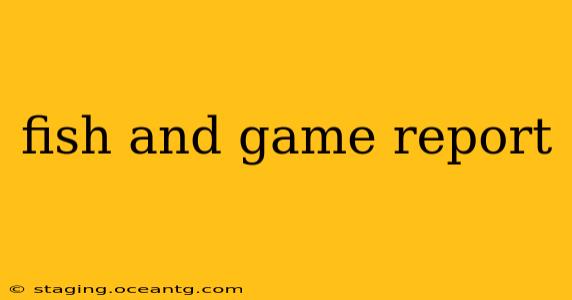Staying informed about fish and game populations is crucial for responsible anglers, hunters, and anyone interested in wildlife conservation. A "fish and game report" encompasses a broad range of information, from fishing conditions and hunting forecasts to wildlife sightings and conservation efforts. This comprehensive guide will explore the various components of a fish and game report and help you understand where to find reliable information.
What is a Fish and Game Report?
A fish and game report provides up-to-date information on the status of fish and wildlife populations within a specific region. These reports can be issued by state or provincial agencies, conservation organizations, or even individual anglers and hunters sharing their experiences. The information contained can vary widely, but often includes:
- Fishing reports: Details on fish species activity, water conditions (temperature, clarity, flow), recommended fishing locations, and recent catches.
- Hunting reports: Information on game animal populations, hunting success rates, hunting regulations, and recent sightings.
- Wildlife observations: Sightings of various animals, both common and rare, along with their locations and behaviors. This can be incredibly valuable for researchers studying migration patterns and population dynamics.
- Conservation updates: News on ongoing conservation projects, environmental concerns, and regulations designed to protect fish and wildlife.
- Regulations and licensing: Information on required licenses, permits, seasons, bag limits, and other relevant regulations.
Where to Find Reliable Fish and Game Reports
The best source for reliable fish and game reports is your local or state/provincial fish and wildlife agency. These agencies often maintain websites and social media accounts with regular updates. Here are some other potential sources:
- State/Provincial Fish and Wildlife Agency Websites: These websites usually offer detailed reports broken down by region, species, and activity (fishing or hunting).
- Local Sporting Goods Stores: Many sporting goods stores display current fishing and hunting reports, often based on information gathered from their customers.
- Online Forums and Social Media Groups: Dedicated fishing and hunting communities online can provide valuable insights and real-time updates, but always verify information with official sources.
- News Outlets and Local Media: Local news sources may include fish and game reports as part of their weather or outdoor recreation coverage.
- Conservation Organizations: Groups dedicated to wildlife conservation often publish reports and updates on their websites and newsletters.
What Information is Typically Included in a Fish and Game Report?
Let's delve deeper into the specific types of information you'll commonly find:
What are the current fishing conditions?
This section typically details water temperature, clarity, and flow rates. It might also specify which techniques (e.g., fly fishing, trolling) are currently most effective and which lures or bait are producing the best results.
What are the best fishing spots right now?
Reports often highlight productive fishing locations, though they may not always disclose precise GPS coordinates to avoid overcrowding or overfishing.
What species of fish are biting?
This section identifies which fish species are actively feeding and which are less active. This information is crucial for anglers to tailor their fishing approach accordingly.
What is the current hunting forecast?
Similar to fishing reports, hunting forecasts provide insights into animal activity, migration patterns, and potential hunting areas. They may also include information on weather conditions that could affect hunting success.
What are the hunting regulations for this season?
This is crucial information. Always check the specific regulations for the area you plan to hunt, including license requirements, bag limits, and legal hunting methods. Failure to comply can result in significant penalties.
The Importance of Responsible Reporting
Responsible reporting of fish and game sightings and catches is crucial for maintaining healthy populations and informing management decisions. When sharing information, avoid disclosing overly precise locations to prevent overexploitation of specific areas.
By consistently consulting reliable fish and game reports, you can improve your chances of a successful outing while contributing to responsible wildlife management. Remember to always follow regulations and practice ethical outdoor recreation.
